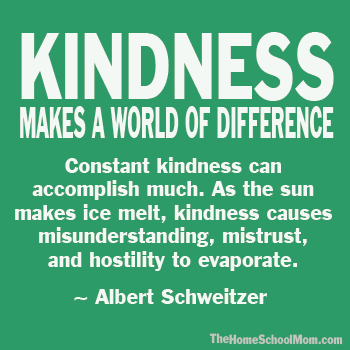
By DeeDee Hughes
By the time we reach adulthood, most of us have figured out that being kind creates a better environment for ourselves and those around us. We all know that kindness can spread warmth in a friendship that has cooled or smooth tensions in an argument. A smile can actually change the world-kind acts and gentle words have cemented friendships between nations.
Constant kindness can accomplish much. As the sun makes ice melt, kindness causes misunderstanding, mistrust, and hostility to evaporate.
---Albert Schweitzer (1875-1965); French philosopher, physician
Kindness is taught in many schools alongside the ABCs and the multiplication tables. And when asked, most parents would probably say we already are teaching our children to be kind every day. But are we? Or rather, how can we do this more consciously and more effectively?
The Ripple Effect: Kindness is Contagious
When Oak Meadow conducted a survey asking what homeschooling families do to cultivate good citizenship, the number one response was treat others with respect and kindness. It seems that for a lot of us, performing acts of kindness is an ingrained part of our lives. The ability to respect and be kind to others is something that has value on a personal level, on an academic level, on a business level, on a political level, and on just about any other level you could name.
A spark of kindness can spread like wildfire. A pair of researchers from University of California, San Diego and Harvard University found that acts of giving expanded exponentially among a group-one good deed leading to another-even when not giving would have resulted in greater personal gain. Another study from researchers at the University of California, Los Angeles and University of Plymouth in the United Kingdom showed that people were more likely to want to help others after they witnessed someone else doing good in the world. We are inspired by acts of kindness and compassion.
Creating a World of Kindness
All parents want their children to grow into loving, kind, compassionate individuals, but usually we don't give much thought to how to encourage these qualities. So what can we do?
First and foremost, treat your children with kindness. Setting a good example starts at home. Humorist Erma Bombeck had some fun turning the spotlight on the common insistence that we treat our children with as much respect as we treat anyone else. She imagined what it would be like to speak to her dinner guests the way she did to her children..."Well, it's about time you two got here! What have you been doing? Dawdling?...Fred! Take it easy on the chip dip or you'll ruin your dinner... Don't tell me your hands are clean, Eleanor. I saw you playing with the dog...Fred, I don't see any cauliflower on your plate...try a spoonful...if you don't try it, you can just forget dessert...Eleanor, don't talk with food in your mouth. I can't understand a word you're saying. And use your napkin."
If you are wincing a little as you laugh, you're not alone! How many times have we interrupted our children but then gotten frustrated when they interrupt us? How many times have we insisted on having the last word, and then gotten angry when our children do the same thing to us? How many times have we forgotten to ask our children nicely to do something but then called them out when they are demanding with us? We've all been there.
Read Part 2 - Simple Steps for Teaching Kindness to Kids
DeeDee Hughes is the managing editor of Oak Meadow's educational journal, Living Education. DeeDee has homeschooled her two teenage sons on and off over the years. She strives to see the kind heart inside every person she meets and teaches her sons to do the same.



 Enjoy these posts from the pages of Living Education, the seasonal journal from our contributing sponsor,
Enjoy these posts from the pages of Living Education, the seasonal journal from our contributing sponsor,
Has it not been accepted for time immemorial that we teach our children, not our guests? It is expected that guests learned not to talk with food in their mouths elsewhere; if not, it is not the host's responsibility. A host's responsibility and a parent's responsibility are different.